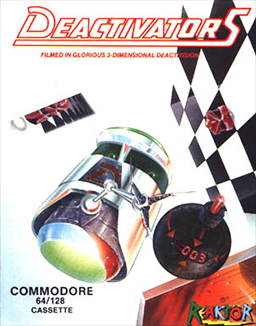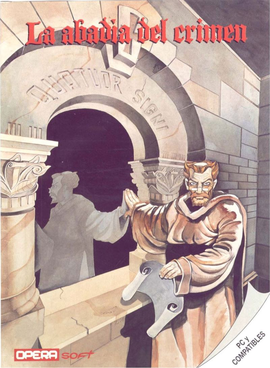Related Research Articles

The Amstrad CPC is a series of 8-bit home computers produced by Amstrad between 1984 and 1990. It was designed to compete in the mid-1980s home computer market dominated by the Commodore 64 and the ZX Spectrum, where it successfully established itself primarily in the United Kingdom, France, Spain, and the German-speaking parts of Europe.

The ZX Spectrum is an 8-bit home computer developed and marketed by Sinclair Research. Considered one of the most influential computers ever made, it is also one of the best-selling British computers ever, with over five million units sold. It was released in the United Kingdom on 23 April 1982, and around the world in the following years, most notably in Europe, the United States, and Eastern Bloc countries.

Amstrad was a British consumer electronics company, founded in 1968 by Alan Sugar. During the 1980s, the company was known for its home computers beginning with the Amstrad CPC and later also the ZX Spectrum range after the Sinclair deal, which led it to have a substantial share of the PC market in Britain. In the following decade it shifted focus towards communication technologies, and its main business during the 2000s was the manufacture of satellite television set-top boxes for Sky, which Amstrad had started in 1989 as the then sole supplier of the emerging Sky TV service.

Game Over is an action video game developed by Dinamic Software and published by Imagine Software in 1987. It was released for the Amstrad CPC, Commodore 64, MSX, Thomson TO7, and ZX Spectrum. The game includes some adventure game elements. A prompted unrated sequel, Game Over II, was released in 1987.
Locomotive Software was a small British software house that did most of its development for Amstrad's home and small business computers of the 1980s. It was founded by Richard Clayton and Chris Hall on 14 February 1983.

Thing on a Spring is a side-scrolling puzzle-platform game released in 1985 for the Amstrad CPC and Commodore 64 by Gremlin Graphics. The player controls a character resembling Zebedee from The Magic Roundabout through a toy factory while avoiding evil toys.

Army Moves is a scrolling shooter game developed by Dinamic Software for the Amiga, Amstrad CPC, Atari ST, Commodore 64, MSX and ZX Spectrum. It is the first chapter of the Moves Trilogy and was followed by Navy Moves in 1987 and Arctic Moves in 1995. It was first released in 1986 and published by Dinamic in Spain and by Imagine Software. Dinamic Software also developed a MS-DOS version of the game, published in 1989 in Spain.

Artic Computing was a software development company based in Brandesburton, England from 1980 to 1986. The company's first games were for the Sinclair ZX81 home computer, but they expanded and were also responsible for various ZX Spectrum, Commodore 64, BBC Micro, Acorn Electron and Amstrad CPC computer games. The company was set up by Richard Turner and Chris Thornton. Charles Cecil, who later founded Revolution Software, joined the company shortly after it was founded, writing Adventures B through D. Developer Jon Ritman produced a number of ZX81 and Spectrum games for Artic before moving to Ocean Software.
Crystal Computing, later renamed Design Design, was a British video game developer founded in 1982 by Chris Clarke and Ian Stamp while students at the University of Manchester. Graham Stafford, Neil Mottershead, Simon Brattel and Martin Horsley, joined the company as it expanded. The company's first software release was a compilation of games for the Sinclair ZX81, though it was with the ZX Spectrum that Crystal found its greatest success. A deal with the machine's manufacturer Sinclair to distribute Crystal's Zeus Assembler gave the company sufficient funds for a major marketing campaign for their next product, Halls of the Things, an arcade adventure game that became their most successful title.
The ZX Spectrum's software library was very diverse. While the majority of the software produced for the system was video games, others included programming language implementations, Sinclair BASIC extensions, databases, word processors, spread sheets, drawing and painting tools, and 3D modelling tools.

Aliens: The Computer Game is a 1986 video game developed by Software Studios and published by Electric Dreams Software initially for Amstrad CPC, Commodore 64 and ZX Spectrum. It is based on the film of the same title. Ports for the Commodore 16 and MSX were developed by Mr. Micro and published in 1987.

Deactivators is a 1986 puzzle video game designed by David Bishop and Chris Palmer, developed by Tigress Marketing and System Software, and published by Ariolasoft's action game imprint Reaktor. The player controls bomb disposal robots known as deactivators and must use them to deactivate bombs planted by terrorists in five research complexes. The concept for the game came from a brainstorming session between Bishop and Palmer; its design and development took five to six months to complete. It was released for the Amstrad CPC 464, Commodore 64, and ZX Spectrum platforms in October 1986.

La abadía del crimen is a video game written by Paco Menéndez with graphics made by Juan Delcán and published in 1987 by Opera Soft. It was conceived as a version of Umberto Eco's 1980 book The Name of the Rose. Paco Menéndez and Opera Soft were unable to secure the rights for the name, so the game was released as La abadía del crimen. "The Abbey of the Crime" was the working title of the novel The Name of the Rose.

10th Frame is a ten-pin bowling simulation game published by Access Software in 1986. Up to eight players can take part in open bowling or a tournament. It was released for the Amstrad CPC, Atari ST, Commodore 64, IBM PC compatibles, MSX, and ZX Spectrum.
Alligata Software Ltd. was a computer games developer and publisher based in Sheffield in the UK in the 1980s.

Colossus Chess is a series of chess-playing computer programs developed by Martin Bryant, commercially released for various home computers in the 1980s.

Batman is a 1986 isometric action-adventure game by Ocean Software for the Amstrad PCW, Amstrad CPC, ZX Spectrum, and MSX, and the first Batman game developed. The game received favourable reviews. An unrelated Batman game was released two years later, titled Batman: The Caped Crusader.

Brian Clough's Football Fortunes is a sports video game featuring English football player Brian Clough. It was released in 1987 for the Amiga, Amstrad CPC, Amstrad PCW, Atari 8-bit computers, Atari ST, BBC Micro, Commodore 16, Plus/4, Commodore 64, MS-DOS, Acorn Electron, MSX, and ZX Spectrum.

OCP Art Studio or Art Studio was a popular bitmap graphics editor for home computers released in 1985, created by Oxford Computer Publishing and written by James Hutchby.
References
- ↑ "Tasword". World of Spectrum. Retrieved 2014-06-19.
- ↑ "Tasword Two". World Of Sam. Retrieved 2014-06-19.
- ↑ Generation-MSX.nl. "Tasword (Eng.) (1984, MSX, Filosoft) | Generation MSX". Generation-msx.nl. Retrieved 2014-06-19.
- ↑ "Tasword Two". World of Spectrum. Retrieved 2014-06-19.
- 1 2 "Tasword 464 - CPCWiki". Cpcwiki.eu. 2011-01-29. Retrieved 2014-06-19.
- ↑ Goodwin, Simon N. (February 1987). "The word according to Tasman: The ABC of +3 writing" (JPG). CRASH (56): 76–77. Retrieved 2008-09-14.
- ↑ "Advertisement July 1982". SINCLAIR USER. Retrieved 2015-02-04.
- 1 2 3 https://archive.org/download/World_of_Spectrum_June_2017_Mirror/World%20of%20Spectrum%20June%202017%20Mirror.zip/World%20of%20Spectrum%20June%202017%20Mirror/sinclair/company-pics/t/TasmanSoftware/TasmanSoftwareCatalogueSpring1986.pdf
- ↑ "Tasword Two at Spectrum Computing - Sinclair ZX Spectrum games, software and hardware". Spectrum Computing.
- ↑ "COMMODORE 64 (C64) - TASWORD 64 - PROGRAM". eBay. Retrieved 2014-06-19.
- ↑ Generation-MSX.nl. "Tasword MSX-2 (1986, MSX2, Filosoft) | Generation MSX". Generation-msx.nl. Retrieved 2014-06-19.
- ↑ "Tasword D 464 - CPCrulez". Cpcrulez.fr. 2011-01-29. Retrieved 2024-08-13.
- ↑ "Tasword 6128 - CPCWiki". Cpcwiki.eu. 2011-01-29. Retrieved 2015-01-29.
- ↑ "TASWORD 8000". Amstrad Action. Retrieved 2015-01-29.
- ↑ "Tasword Einstein". Computing History. Retrieved 2014-06-19.